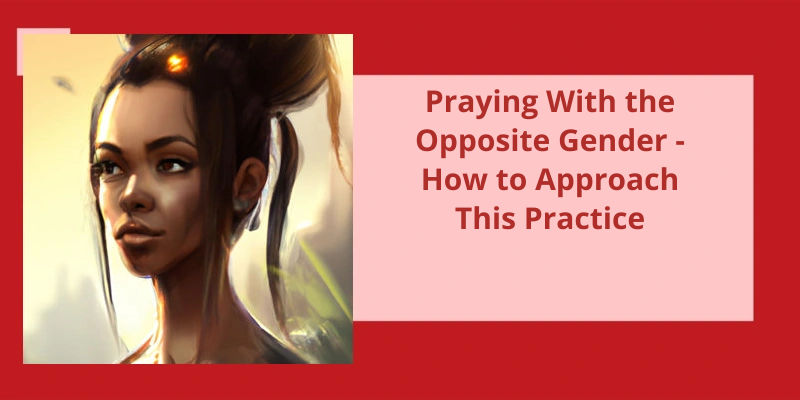Prayer is a spiritual practice that holds different meanings and traditions for various individuals and communities. It’s an act of connecting with the divine, seeking guidance, and expressing gratitude. However, in certain circumstances and contexts, praying with the opposite gender can be a sensitive and controversial issue. Cultural and religious norms, beliefs, and values influence how individuals approach praying with people of different genders. Some view it as a natural expression of faith and unity, while others view it as inappropriate, distracting, or even sinful.
What Is the Gender of God in the Hebrew Bible?
One exception to this is seen in the Book of Proverbs, where wisdom is personified as a woman. The term used for wisdom is “Chokhmah”, which in Hebrew is a feminine noun. However, it’s important to note that this personification doesn’t represent God as a whole, but rather a specific attribute.
In Jewish tradition, the gender of God is often considered beyond human comprehension and therefore, not assigned a specific gender. However, the Hebrew language does assign gender to all nouns, including those referring to God. The term “Elohim” is Hebrew for God and is a masculine noun, while “Shekhinah”, a term used to describe the presence of God, is a feminine noun.
Despite the limited reference to a feminine personification of God in Jewish scripture, there’s a strong tradition of acknowledging the feminine aspect of God through prayer and ritual. For example, the Kabbalistic tradition recognizes the feminine aspect of God in the form of the Shekhinah, often referred to as the divine feminine. The Shekhinah is associated with the nurturing, compassionate and protective qualities of God.
In addition, there are a number of powerful female figures in Jewish scripture who serve as important role models for women. Examples include Sarah, Rebecca and Rachel in the Book of Genesis, Deborah the prophetess in the Book of Judges, and Esther in the Book of Esther.
It’s widely believed that God transcends the binary gender categories of male and female, as the divine essence is considered to be beyond physical attributes. However, the Bible seems to use masculine pronouns and metaphors when referring to God, indicating the common understanding of God as a masculine entity. Let’s explore this apparent contradiction and examine the biblical basis for such beliefs.
Does the Bible Say God Is Neither Male or Female?
This analogy is derived from references in the Hebrew Bible, which portray God in typically masculine terms, such as “Father” and “Lord.”. However, these references aren’t meant to be taken literally as a portrayal of Gods gender, but rather as a way of expressing Gods power, authority, and protection over humanity.
Similarly, the New Testament continues to use masculine language to refer to God, but also includes feminine imagery such as a mother hen gathering her chicks under her wings. This diversity of imagery emphasizes Gods nurturing and protective qualities, which aren’t exclusive to either gender.
In addition, some Biblical scholars argue that there are certain passages that suggest a feminine aspect to God, such as the depiction of God as a woman giving birth in Isaiah 42:However, these interpretations are more contested and not widely accepted within traditional Christian theology.
Ultimately, the language used to refer to God is subject to cultural and historical context, and should be interpreted in a way that reflects the fullness of Gods character and qualities. Regardless of whether God is referred to as male or female or neither, the central message of the Bible is that God is a loving creator who desires a relationship with humanity, and who sent his son Jesus to reconcile us to him.
Now that we understand the importance of respecting individuals regardless of gender, it’s crucial to delve deeper into why respect towards the opposite gender is particularly important. In this article, we will explore the ways in which cultivating a respectful attitude towards the opposite gender can foster healthy relationships and contribute to societal progress.
Why Is Respect for the Opposite Gender Important?
It’s important to understand that respect for the opposite gender isn’t just about basic politeness or courtesy, but it’s a fundamental principle that speaks to greater societal norms. When we respect the opposite gender, we aren’t only acknowledging their role in society, but we’re also respecting their innate worth as human beings. It’s through this mutual understanding and respect that we can create a cultural paradigm that supports a fair and just society.
Without respect for the opposite gender, we’re perpetuating harmful stereotypes and biases that can lead to marginalization and oppression. It’s essential to give people the space to be themselves, regardless of their gender identity. Respecting the opposite gender isnt just about promoting equality; it’s also about creating a safe environment for everyone to thrive.
Furthermore, it’s important to understand that gender norms are entirely arbitrary, and they often cause needless suffering and harm. Instead, we recognize that everyone has the potential to contribute meaningfully to society, regardless of their gender. This is particularly true when it comes to issues such as employment, politics, and other positions of power.
As we build a society that’s more equal and just, it’s essential to recognize that we’re all in this together. We need each other to survive, and we must work together to create a world that’s more inclusive, empathetic, and respectful.
We must work together to create a culture of mutual understanding and empathy that allows us to build strong, meaningful relationships across gender lines. We must acknowledge and celebrate the contributions that each gender makes to our society, and we must work together to overcome the biases and prejudices that prevent us from creating a more just and equal world.
The Historical Context of Gender Relations and It’s Relevance Today.
This article explores the social, cultural, and political factors that have influenced gender relations throughout history and their impact on contemporary society. It examines the evolution of gender roles, the struggles for gender equality, and the persistence of gender-based discrimination and inequality. By understanding the historical context of gender relations, we can better comprehend the challenges that we face today and work towards creating a more equitable and inclusive society.
Now that we’ve established where in the Bible it mentions God creating both male and female, let’s dive deeper into the significance of this passage and what it teaches us about gender and identity in Christianity.
Where in the Bible Does It Say God Made Them Male and Female?
This passage is significant for several reasons. Firstly, it asserts that both men and women share the same divine image, and are therefore equally valuable and deserving of respect. This is an important message in a society where women were often viewed as inferior to men. Secondly, it establishes the idea that gender is a fundamental aspect of human identity that’s created by God. This means that gender isn’t simply a social construct or a matter of personal choice, but something that’s imbued with sacred significance.
However, it’s worth noting that there are different interpretations of this passage among different Christian traditions. Some argue that it means that God created only two genders (male and female) and that any other gender identities are therefore contrary to Gods design. Others take a more inclusive view, arguing that the purpose of the passage is to emphasize the equal value of men and women in Gods eyes, but that it doesn’t necessarily preclude the existence of other gender identities.
Regardless of ones interpretation, the passage in Genesis 1:27 is an important starting point for any discussion of gender and sexuality in the Bible. It reminds us that gender is a divine creation, and therefore something to be respected and honored, rather than something to be manipulated or suppressed. It also challenges us to think about the ways in which our cultural assumptions about gender may be at odds with Gods vision for humanity.
How Have Modern Christian Theologians Engaged With This Passage and It’s Implications for Contemporary Understandings of Gender and Sexuality?
- Many modern Christian theologians have engaged with this passage, seeking to understand it’s implications for contemporary understandings of gender and sexuality.
- Some theologians argue that the passage should be understood in it’s historical context, and that it’s teachings about gender roles may not be applicable to today’s society.
- Others argue that the passage is relevant to contemporary discussions about gender and sexuality, and that it provides valuable guidance for individuals and communities.
- Regardless of their specific interpretations of the passage, most modern Christian theologians agree that it’s important to engage with biblical teachings about gender and sexuality in order to develop a more nuanced and compassionate understanding of these issues.
When discussing the Holy Spirit in theological circles, one question that often arises is whether the Holy Spirit has a gender. This topic has been debated over the centuries, with various arguments put forth both in favor of and against the idea of the Holy Spirit having a gender. One point of confusion stems from the fact that most English translations of the New Testament refer to the Holy Spirit as masculine, using the Greek word “Paraclete” which is a masculine noun. However, this issue isn’t necessarily conclusive in determining the gender of the Holy Spirit.
Does the Holy Spirit Have a Gender?
However, scholars have debated whether the Holy Spirit actually has a gender, as the concept of gender is a human construct and doesn’t necessarily apply to spiritual beings. Some argue that the use of masculine language is simply a convention of the Greek language and doesn’t indicate the gender of the Holy Spirit. Others point out that the Hebrew word for spirit, “ruach”, is a feminine noun, which could suggest that the Holy Spirit is feminine.
This interpretation is often associated with feminist theology, which seeks to recover the feminine aspects of God that have been marginalized in traditional Christian theology. Some groups have even created new liturgies and prayers that refer to the Holy Spirit as “She” rather than “He”.
Regardless of ones interpretation, it’s clear that the Holy Spirit is an essential part of Christian theology and plays a crucial role in the lives of believers.
Ultimately, what’s most important isn’t the gender of the Holy Spirit, but the role that she plays in the lives of believers. Whether viewed as masculine, feminine, or beyond gender, the Holy Spirit is a powerful and transformative force that shapes our lives and leads us closer to God.
Conclusion
However, it’s important to remember that prayer is a personal and intimate connection between each individual and their chosen faith. It’s essential to maintain respect for one another's beliefs and practices, and to foster a welcoming and inclusive environment for all members of the faith community. Ultimately, the focus should be on the shared goal of promoting peace, understanding, and love within the community, regardless of gender.






